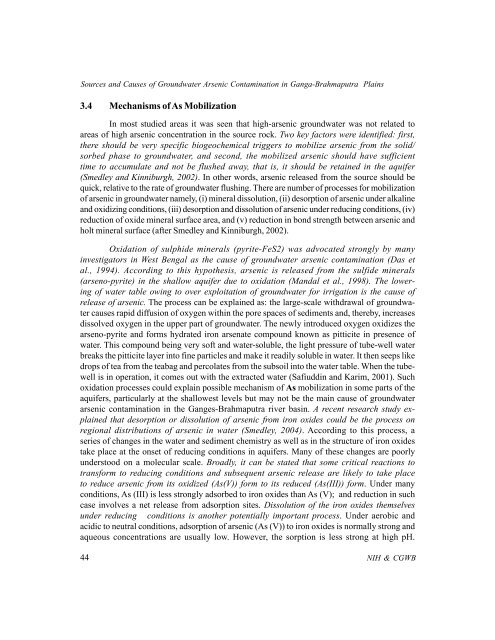Mitigation and Remedy of Groundwater Arsenic Menace in India
Mitigation and Remedy of Groundwater Arsenic Menace in India
Mitigation and Remedy of Groundwater Arsenic Menace in India
Create successful ePaper yourself
Turn your PDF publications into a flip-book with our unique Google optimized e-Paper software.
Sources <strong>and</strong> Causes <strong>of</strong> <strong>Groundwater</strong> <strong>Arsenic</strong> Contam<strong>in</strong>ation <strong>in</strong> Ganga-Brahmaputra Pla<strong>in</strong>s3.4 Mechanisms <strong>of</strong> As MobilizationIn most studied areas it was seen that high-arsenic groundwater was not related toareas <strong>of</strong> high arsenic concentration <strong>in</strong> the source rock. Two key factors were identified: first,there should be very specific biogeochemical triggers to mobilize arsenic from the solid/sorbed phase to groundwater, <strong>and</strong> second, the mobilized arsenic should have sufficienttime to accumulate <strong>and</strong> not be flushed away, that is, it should be reta<strong>in</strong>ed <strong>in</strong> the aquifer(Smedley <strong>and</strong> K<strong>in</strong>niburgh, 2002). In other words, arsenic released from the source should bequick, relative to the rate <strong>of</strong> groundwater flush<strong>in</strong>g. There are number <strong>of</strong> processes for mobilization<strong>of</strong> arsenic <strong>in</strong> groundwater namely, (i) m<strong>in</strong>eral dissolution, (ii) desorption <strong>of</strong> arsenic under alkal<strong>in</strong>e<strong>and</strong> oxidiz<strong>in</strong>g conditions, (iii) desorption <strong>and</strong> dissolution <strong>of</strong> arsenic under reduc<strong>in</strong>g conditions, (iv)reduction <strong>of</strong> oxide m<strong>in</strong>eral surface area, <strong>and</strong> (v) reduction <strong>in</strong> bond strength between arsenic <strong>and</strong>holt m<strong>in</strong>eral surface (after Smedley <strong>and</strong> K<strong>in</strong>niburgh, 2002).Oxidation <strong>of</strong> sulphide m<strong>in</strong>erals (pyrite-FeS2) was advocated strongly by many<strong>in</strong>vestigators <strong>in</strong> West Bengal as the cause <strong>of</strong> groundwater arsenic contam<strong>in</strong>ation (Das etal., 1994). Accord<strong>in</strong>g to this hypothesis, arsenic is released from the sulfide m<strong>in</strong>erals(arseno-pyrite) <strong>in</strong> the shallow aquifer due to oxidation (M<strong>and</strong>al et al., 1998). The lower<strong>in</strong>g<strong>of</strong> water table ow<strong>in</strong>g to over exploitation <strong>of</strong> groundwater for irrigation is the cause <strong>of</strong>release <strong>of</strong> arsenic. The process can be expla<strong>in</strong>ed as: the large-scale withdrawal <strong>of</strong> groundwatercauses rapid diffusion <strong>of</strong> oxygen with<strong>in</strong> the pore spaces <strong>of</strong> sediments <strong>and</strong>, thereby, <strong>in</strong>creasesdissolved oxygen <strong>in</strong> the upper part <strong>of</strong> groundwater. The newly <strong>in</strong>troduced oxygen oxidizes thearseno-pyrite <strong>and</strong> forms hydrated iron arsenate compound known as pitticite <strong>in</strong> presence <strong>of</strong>water. This compound be<strong>in</strong>g very s<strong>of</strong>t <strong>and</strong> water-soluble, the light pressure <strong>of</strong> tube-well waterbreaks the pitticite layer <strong>in</strong>to f<strong>in</strong>e particles <strong>and</strong> make it readily soluble <strong>in</strong> water. It then seeps likedrops <strong>of</strong> tea from the teabag <strong>and</strong> percolates from the subsoil <strong>in</strong>to the water table. When the tubewellis <strong>in</strong> operation, it comes out with the extracted water (Safiudd<strong>in</strong> <strong>and</strong> Karim, 2001). Suchoxidation processes could expla<strong>in</strong> possible mechanism <strong>of</strong> As mobilization <strong>in</strong> some parts <strong>of</strong> theaquifers, particularly at the shallowest levels but may not be the ma<strong>in</strong> cause <strong>of</strong> groundwaterarsenic contam<strong>in</strong>ation <strong>in</strong> the Ganges-Brahmaputra river bas<strong>in</strong>. A recent research study expla<strong>in</strong>edthat desorption or dissolution <strong>of</strong> arsenic from iron oxides could be the process onregional distributions <strong>of</strong> arsenic <strong>in</strong> water (Smedley, 2004). Accord<strong>in</strong>g to this process, aseries <strong>of</strong> changes <strong>in</strong> the water <strong>and</strong> sediment chemistry as well as <strong>in</strong> the structure <strong>of</strong> iron oxidestake place at the onset <strong>of</strong> reduc<strong>in</strong>g conditions <strong>in</strong> aquifers. Many <strong>of</strong> these changes are poorlyunderstood on a molecular scale. Broadly, it can be stated that some critical reactions totransform to reduc<strong>in</strong>g conditions <strong>and</strong> subsequent arsenic release are likely to take placeto reduce arsenic from its oxidized (As(V)) form to its reduced (As(III)) form. Under manyconditions, As (III) is less strongly adsorbed to iron oxides than As (V); <strong>and</strong> reduction <strong>in</strong> suchcase <strong>in</strong>volves a net release from adsorption sites. Dissolution <strong>of</strong> the iron oxides themselvesunder reduc<strong>in</strong>g conditions is another potentially important process. Under aerobic <strong>and</strong>acidic to neutral conditions, adsorption <strong>of</strong> arsenic (As (V)) to iron oxides is normally strong <strong>and</strong>aqueous concentrations are usually low. However, the sorption is less strong at high pH.44NIH & CGWB




